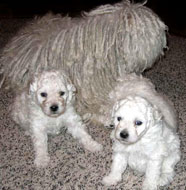| |
|
|
Puli Information

Puli Facts
| Size |
Medium |
| Male Max Weight |
25-35 lb |
| Female Max Weight |
25-35 lb |
| Life Span |
10-15 years |
| Energy Level |
 |
| Ease of Training |
 |
| Grooming |
 |
| Shedding |

|
| Exercise Requirements |

|
| Playfulness |

|
| Affection Level |

|
| Good With Dogs |

|
| Good With Pets |

|
| Good With Strangers |

|
| Watchdog Ability |

|
| Protection Ability |

|
| Cold Tolerance |

|
| Heat Tolerance |

|
Puli Temperament
|
As the Puli is
a natural herder, it is constantly busy and looking for something to do. This
consistent curiosity can be satisfied with a walk, job, or a lively play session.
The Puli can survive in the outdoors with temperate to cool climates, but can also find
success as an indoor house pet. The extensive coat of the Puli can hold significant
debris, but the coat is actually a nonshedding coat. If the coat is to be brushed,
it must be done at least every other day. If the coat is to be corded, the cords
will need regular attention to separate them since they can contain dirt. To bathe
a Puli takes a great amount of time and effort and it can take up to an entire day for
the coat to fully dry. The coat can be cut, however the signature appearance of the
breed is then
lost.
|
Puli Upkeep
|
The Puli is a breed that is full of life with mounds of
energy. It is inquisitive and lively with a strong natural intelligence.
Daily exercise is required to satisfy the needs of this busy breed. Although
vivacious, it can be tough and stubborn and may come at other dogs with aggression.
The Puli is a protector and is very in tune with its surroundings. It does have a
tendency to bark
regularly.
|
Puli Health Concerns
|
The major health concern for the Puli is known as CHD, or Canine
Hip Dysplasia. This is a disease that involves improper growth of the hip and can
eventually lead to arthritis. On occasion, PRA, or Progressive Retinal Atrophy is
seen in this breed, which can lead to blindness. Deafness is also seen occasionally
with the Puli. To maintain good health, the eyes, hips, and hearing should be
tested often. A healthy Puli will live for approximately 10 to 15 years on
average.
|
Puli History
|
During the ninth century, the ancestor of today’s Puli arrived
in the central Danube area along with the Magyar tribes from the eastern Urals. The
Magyar tribes brought along a range of Sheepdogs and mixed with the Turkish people during
their travels. The Puli has a resemblance to the Tibetan Spaniel and some believe
that this journey played a role in its origin. Agile for their small stature, these
small dogs had the ability to herd sheep and turn a sheep over by leaping onto its back.
They were easily recognizable by the shepherd due to their dark coloring among the sheep.
The larger varieties were most likely used as guard dogs at night by the Magyar's, while
the smaller stature varieties performed the herding duties. The Puli breed was close to
extinct in the sixteenth century when European invaders took over Hungary and brought in
their people, sheep, and dogs. These foreign dogs were used for breeding with the native
Pulik, producing a Pumi and the continued inter breeding of the Puli and Pumi almost
caused the loss of the Puli's existence. The Puli was eventually resurrected in the
1900s. The Pulik in Hungary at this time were of a great variety in height. There were
large "police" varieties that acted as guard dogs. There were medium "working" class Puli
that worked as the herders and have since become the desired size. And there were small
"dwarf" sized versions as well. The United States Department of Agriculture took
advantage of the natural herding abilities of the Puli in 1935 and imported them into the
Country. The effort to improve herding dogs in the United States through this maneuver
was slightly stalled by the ongoing war, but the breed did gain AKC recognition in 1936.
As many Hungarians began to escape the war and conflict, their dogs came along for the
ride and this caused a quick spread of the breed throughout Europe. Today the Puli exists
scarcely as a family dog in the home or a show dog, but continues to be a skilled
herder.
|
Puli Pictures
|
Puppies

Middle
Aged

|
Puli Videos
|
|
|